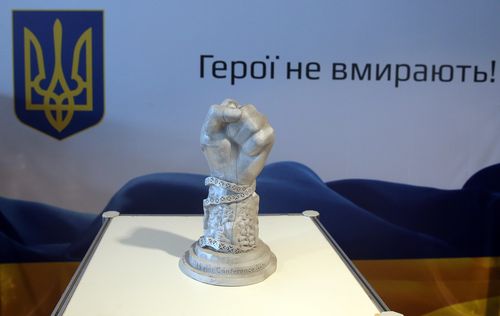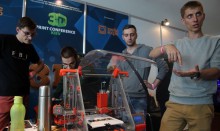3D-printing inevitably enters our everyday life. Recently, Australian engineers have printed a fragment of the human skeleton. The titanium ribcage has been successfully transplanted to a 54-year-old patient who had cancer. And in late August, NASA had tested a turbopump unit, almost half of which is 3D-printed parts.
Ukrainians are also trying to keep up with global trends and actively introducing the 3D-production in various implementations. Past week in Kyiv, one could have learned how to do it, on the second exhibition-conference for the three-dimensional printing technology – the 3D Print Conference Kyiv.
Over a thousand people had visited this event just in a day. This year, the 3D Print Conference has also expanded into three thematic areas: the conference zone, the exhibition area, and the workshop for master classes.
During the day, more than 15 speakers from different countries had appeared at the stage of the conference zone. Among them were the representatives of Imatek-Esko, Materialise, Envision TEC, intRobots, Smart Print, 3D Printer OS, ARan Ed, White Ant, as well as foreign experts from Germany, the US, and Belgium.
And despite the limited appearance time – 20 minutes on average for every speaker – the participants managed to discuss many issues related to the 3D-printing, ranging from the impact of new technologies on the learning process to their usage in the military industry.
“The 3D-printing is a technology which has already fully adapted to play a significant role in the business. In the monetary terms, this year 3D-printing market has increased almost twofold,” said Yevhen Kozhukhovsky, CEO of Smart Print.
According to him, every two years the printing speed doubles, the price for printers halves. “This opens up great prospects for the next five years. It makes sense to wait. But if you want to make money, it is possible even now,” added Kozhukhovsky.

ONE OF THE MAIN ATTRACTIONS OF THE EXHIBITION WAS A 3D-PRINTED MODEL FOR THE HEAVENLY HUNDRED MONUMENT. THE PLASTER PROTOTYPE 40 cm IN HEIGHT WILL BE SOON DONATED TO KYIV AUTHORITIES
Today, experts estimate that the 3D-printing in the world finds the most effective implementation in such areas as prototyping, concept testing, and production. Slightly less popular is the three-dimensional printing in marketing, advertising, education, and hobbies.
In Ukraine and the CIS countries, the 3D-printing is popular in the manufacturing of components, prototypes, models, and miniatures. The technology is the least used in the production of jewelry and art objects. At the same time, notes Kozhukhovsky, the latter are the niches which are worthy of attention to the newcomers in the 3D-printing market.
No less interesting is the use of the three-dimensional printing technology in medicine. The 3D-printing in the world is already widely used to build medical prostheses... and organs. “The main advantage of the 3D-printing is the freedom of choosing the object’s shape. That is a good opportunity for mass personalization, which allows approaching every patient individually,” said Oleksandr Nam, the head of EnvisionTEC’s development department.
The doctor provided statistics – as of 2013, transplant waiting list in the United States was 122,546 people, of whom 22 were dying daily. In the EU the list included 63,000 people, 11 were dying daily. “Today, the medicine faces new challenges. Namely, how to help the human body replace organs that are breaking down. The same goes for people who are waiting for organs to be transplanted,” said Nam. “There will always be the gap between the demand for organs and their availability. But the 3D-printing may be able to solve this problem.”
For example, consider the making of tissue directly on a patient. “If you have a burn on your hand, you come to the hospital, and then put your hand under the 3D-scanner which scans the damage. It will take samples of your cells and create the necessary volume of them outside your body. Afterwards, you come again and the 3D-printer makes you a completely new skin to cover the damaged area,” he explains.

DURING INTROBOTS MASTER CLASS CHILDREN WERE LEARNING THE USEFUL PROGRAMS FOR WORKING WITH 3D PRINTERS AND MAKING ROBOTS
One of the major discoveries of the exhibition area was the 3D-printed model of the Heavenly Hundred monument. “We want to do something for Kyiv and perpetuate the memory of our heroes. The competition involved only Ukrainian artists and designers. We understood that the Ukrainian spirit can be lifted only by a Ukrainian,” says Mares Shamzhi, the conference organizer.
The model of the monument is printed with plaster; its height is 40 cm. Later it will be donated to Kyiv authorities, as organizers of the 3D Print Conference Kyiv had expressed the desire to locate it somewhere in the capital. By the way, past year the organizers have set and registered a record by 3D-printing the largest Tryzub, Ukrainian emblem.
Also a lot of visitors’ attention received a printer that prints with chocolate. “Our technology allows printing not only with chocolate, but with clay,” said Oleh Rybko, operations director of 3D-Circle. In fact, he noted, the printer can print with any other food products, the structure of which resembles that of chocolate. “In the world, for example, there is a technology for mixing the products in order to make softer food for people who need it. Since recently, by the way, even pizza dough has been manufactured on a 3D-printer. And in New York some are printing pastries,” adds Rybko.
In Ukraine the technology does not have such popularity yet. But, as he said, in 10-15 years the 3D-printing will become a commonplace phenomenon. “The fact is that people here do not understand yet how the 3D-printing might be used in everyday life. But we do so much to make it accessible. Now we are developing a web portal, which will communicate the benefits of the 3D printing to Ukrainians, also we are going to launch educational courses,” said Rybko. “I became interested in the technology at the moment I realized that if it is possible to print food, the problem of hunger might be eliminated over time. And when this need will be taken care of, then, according to Maslow’s pyramid, the world would change dramatically. And we must be ready for this.”
Additionally, visitors had been able to get acquainted with the principles of the 3D-printing and the types of production, to see souvenirs in the form of vases, cats, globes, and Eiffel towers, and to print a 3D-digital selfie of themselves.
Throughout the day at the workshop basic master classes on how to start working with the 3D-printer had taken place, as well as the master classes for amateurs and printer owners, and the trainings and case studies on printing optimization for company representatives.
The youngest and most inquisitive conference visitors also did not have to be bored. A special workshop zone had been dedicated to the kids, on which they familiarized with the principles of the 3D-technologies and even helped to “revive” a 3D-printed robot.







